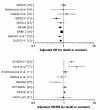The "smoker's paradox" in patients with acute coronary syndrome: a systematic review
- PMID: 21861870
- PMCID: PMC3179733
- DOI: 10.1186/1741-7015-9-97
The "smoker's paradox" in patients with acute coronary syndrome: a systematic review
Abstract
Background: Smokers have been shown to have lower mortality after acute coronary syndrome than non-smokers. This has been attributed to the younger age, lower co-morbidity, more aggressive treatment and lower risk profile of the smoker. Some studies, however, have used multivariate analyses to show a residual survival benefit for smokers; that is, the "smoker's paradox". The aim of this study was, therefore, to perform a systematic review of the literature and evidence surrounding the existence of the "smoker's paradox".
Methods: Relevant studies published by September 2010 were identified through literature searches using EMBASE (from 1980), MEDLINE (from 1963) and the Cochrane Central Register of Controlled Trials, with a combination of text words and subject headings used. English-language original articles were included if they presented data on hospitalised patients with defined acute coronary syndrome, reported at least in-hospital mortality, had a clear definition of smoking status (including ex-smokers), presented crude and adjusted mortality data with effect estimates, and had a study sample of > 100 smokers and > 100 non-smokers. Two investigators independently reviewed all titles and abstracts in order to identify potentially relevant articles, with any discrepancies resolved by repeated review and discussion.
Results: A total of 978 citations were identified, with 18 citations from 17 studies included thereafter. Six studies (one observational study, three registries and two randomised controlled trials on thrombolytic treatment) observed a "smoker's paradox". Between the 1980s and 1990s these studies enrolled patients with acute myocardial infarction (AMI) according to criteria similar to the World Health Organisation criteria from 1979. Among the remaining 11 studies not supporting the existence of the paradox, five studies represented patients undergoing contemporary management.
Conclusion: The "smoker's paradox" was observed in some studies of AMI patients in the pre-thrombolytic and thrombolytic era, whereas no studies of a contemporary population with acute coronary syndrome have found evidence for such a paradox.
Figures


Similar articles
-
Systemic pharmacological treatments for chronic plaque psoriasis: a network meta-analysis.Cochrane Database Syst Rev. 2021 Apr 19;4(4):CD011535. doi: 10.1002/14651858.CD011535.pub4. Cochrane Database Syst Rev. 2021. Update in: Cochrane Database Syst Rev. 2022 May 23;5:CD011535. doi: 10.1002/14651858.CD011535.pub5. PMID: 33871055 Free PMC article. Updated.
-
Prognosis of adults and children following a first unprovoked seizure.Cochrane Database Syst Rev. 2023 Jan 23;1(1):CD013847. doi: 10.1002/14651858.CD013847.pub2. Cochrane Database Syst Rev. 2023. PMID: 36688481 Free PMC article.
-
Drugs for preventing postoperative nausea and vomiting in adults after general anaesthesia: a network meta-analysis.Cochrane Database Syst Rev. 2020 Oct 19;10(10):CD012859. doi: 10.1002/14651858.CD012859.pub2. Cochrane Database Syst Rev. 2020. PMID: 33075160 Free PMC article.
-
Sertindole for schizophrenia.Cochrane Database Syst Rev. 2005 Jul 20;2005(3):CD001715. doi: 10.1002/14651858.CD001715.pub2. Cochrane Database Syst Rev. 2005. PMID: 16034864 Free PMC article.
-
Systemic pharmacological treatments for chronic plaque psoriasis: a network meta-analysis.Cochrane Database Syst Rev. 2017 Dec 22;12(12):CD011535. doi: 10.1002/14651858.CD011535.pub2. Cochrane Database Syst Rev. 2017. Update in: Cochrane Database Syst Rev. 2020 Jan 9;1:CD011535. doi: 10.1002/14651858.CD011535.pub3. PMID: 29271481 Free PMC article. Updated.
Cited by
-
Prevalence and impact of tobacco use disorder on in-hospital mortality in patients hospitalized with non-group 1 pulmonary hypertension: a nationwide propensity score-matched analysis, 2019.EXCLI J. 2023 Nov 28;22:1200-1210. doi: 10.17179/excli2023-6409. eCollection 2023. EXCLI J. 2023. PMID: 38204965 Free PMC article.
-
The effects of smoking on adolescent trauma patients: a propensity-score-matched analysis.Pediatr Surg Int. 2020 Jun;36(6):743-749. doi: 10.1007/s00383-020-04654-8. Epub 2020 Mar 31. Pediatr Surg Int. 2020. PMID: 32236667 Free PMC article.
-
Smoking status and survival: impact on mortality of continuing to smoke one year after the angiographic diagnosis of coronary artery disease, a prospective cohort study.BMC Cardiovasc Disord. 2014 Oct 1;14:133. doi: 10.1186/1471-2261-14-133. BMC Cardiovasc Disord. 2014. PMID: 25274407 Free PMC article.
-
Association between smoking and in-hospital mortality in patients with left ventricular dysfunction undergoing coronary artery bypass surgery: a propensity-matched study.BMC Cardiovasc Disord. 2021 May 12;21(1):236. doi: 10.1186/s12872-021-02056-9. BMC Cardiovasc Disord. 2021. PMID: 33980149 Free PMC article.
-
Impact of Smoking Reduction Scenarios on the Burden of Myocardial Infarction in the French Population Until 2035.Clin Epidemiol. 2024 Sep 7;16:605-616. doi: 10.2147/CLEP.S440815. eCollection 2024. Clin Epidemiol. 2024. PMID: 39262929 Free PMC article.
References
-
- Helmers C. Short and long-term prognostic indices in acute myocardial infarction. A study of 606 patients initially treated in a coronary care unit. Acta Med Scand Suppl. 1973;555:7–26. - PubMed
-
- Libby P, Bonow RO, Mann DL, Zipes DP. Braunwald's Heart Disease: A Textbook of Cardiovascular Medicine. Philadelphia: Elsevier Health Sciences; 2007. - PubMed
Publication types
MeSH terms
LinkOut - more resources
Full Text Sources

